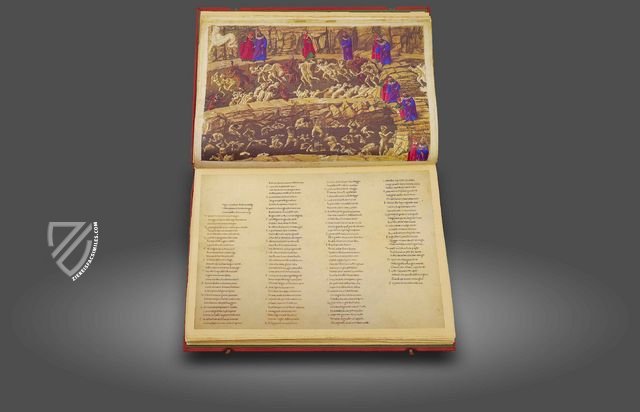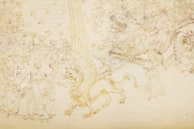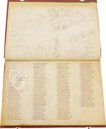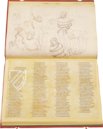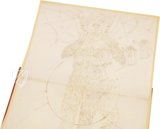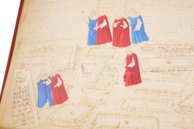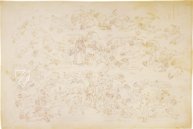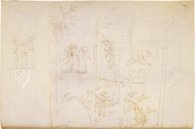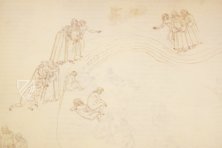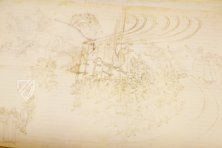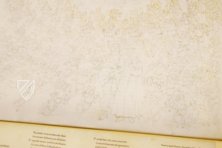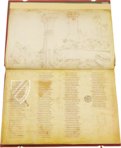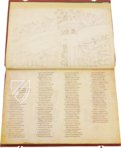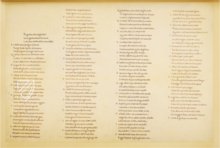Divine Comedy of Sandro Botticelli
(3,000€ - 7,000€)
The Divine Comedy with illustrations by Sandro Botticelli originates from between 1480 and 1490 in Florence and was commissioned by Lorenzo di Pierfrancesco de' Medici (1463–1503). This significant work of world literature was and continually is received in the visual arts. The breathtaking drawings of this edition are counted among the most famous works by Botticelli.
The Divine Comedy of Sandro Botticelli
One of the most important works in world literature originates from the period between 1307 and around 1321 in Italy. The Divine Comedy, also known by its Italian title Divina Comedia, is simultaneously the first and most famous Italian piece of literature. Dante Alighieri composed this timeless tale. The work has been adapted into countless films and musical pieces, paintings and illustrations, sculptures and architecture, and even a video game has been inspired by the Divine Comedy. Hardly any other literary work from the Middle Ages has had such an influence. The world famous painter Sandro Botticelli made a total of 92 partly coloured silverpoint drawings, which adorn this edition of the Divine Comedy and belongs among the master’s greatest artworks.
Immortal Literature
The story of the Divine Comedy is a personal vision of Dante’s as he represents Hell, Purgatory, and Paradise. It is a tale full of symbol and allegories, a philosophical fiction that is vividly told in spite of the abstract story. Dante played on man’s primal fears, brought past events to life, and slipped in contemporary theological insights. The impressive epic astounds through its figurative language, its irony, and its striking comparisons. Even if everyone does not understand this staggering fiction, the Divine Comedy has nonetheless remained one of the most important works of world literature to this day.
Botticelli’s Illumination
Botticelli was one of the significant painters of the Early Italian Renaissance. Today, his paintings hang in the most important art museums in the world. His picture cycle of the Divine Comedy originates from between 1482 and 1503 at the behest of Lorenzo di Pierfrancesco de' Medici (1463–1503). These 92 illuminations are counted among his most famous works. In technical perfection, the silverpoint drawings exemplify the events, people, and fable-like creatures of the Divine Comedy. The edition of the epic with Botticelli’s illustrations was commissioned by the Renaissance Prince Alfonzo de Medici and originates from between 1480 and 1490. This inestimably valuable manuscript exists today in the Vatican Library.
Codicology
- Alternative Titles
- Dante Alighieri's Divine Comedy
Divina Commedia con illustrazioni di Sandro Botticelli
Dantes Divina commedia mit den Illustrationen von Sandro Botticelli
Die Göttliche Komödie mit Illustrationen von Sandro Botticelli - Size / Format
- 184 pages / 48.0 × 33.0 cm
- Origin
- Italy
- Date
- 1480–1490
- Epochs
- Style
- Genre
- Language
- Script
- Humanistic Rotunda
- Illustrations
- 92 drawings, 4 of which are completely illuminated
- Patron
- Lorenzo di Pierfrancesco de' Medici (1463–1503)
- Artist / School
- Dante Alighieri (1265–1321) (author)
Sandro Botticelli (ca. 1445–1510) (illuminator)
Nicolaus Mangona (scribe) - Previous Owners
- Queen Christina of Sweden (1626–89)
Divine Comedy of Sandro Botticelli
Lucifer
Botticelli’s second drawing of Lucifer from Inferno XXXIV spans two pages and also illustrates the full story of this canto. Aside from depicting Lucifer as a furry monster with bat wings and three heads – each with terrifying visages and two horns – Dante and Virgil are shown progressing through the Ninth Circle towards the center of Hell. The detail of this unfinished miniature is impressive, and one can only imagine how terrifying it would be if it were finished in full color.

Divine Comedy of Sandro Botticelli
Map of Hell
This magnificent full-page miniature presents Hell as an abyss resembling a quarry consisting of nine rings with Lucifer stuck in ice at the center. Although Hell is described in the Bible as a lake of fire, but both Dante and Botticelli conceived of it as a cave created when God threw Lucifer out of Heaven.
The first five rings are reserved for the unbaptized, “good” heathens ignorant of Christ, and those unable to control their lust, gluttony, greed, anger, and revenge. Murderers, suicides, blasphemers, sodomites, and anyone guilty of heresy and violence dwell in the next two rings. The last two rings contain those guilty of fraud and treachery such as witches, thieves, astrologers, seducers, corrupt politicians, alchemists and sowers of discord.

#1 Dantes Divina Commedia mit den Illustrationen von Sandro Botticelli
Language: German
(3,000€ - 7,000€)
#2 Dantes Divina Commedia mit den Illustrationen von Sandro Botticelli (Normal Edition)
Language: German
(1,000€ - 3,000€)
#3 Divina Commedia Illustrata da Sandro Botticelli
Language: Italian
(1,000€ - 3,000€)
- Treatises / Secular Books
- Apocalypses / Beatus
- Astronomy / Astrology
- Bestiaries
- Bibles / Gospels
- Chronicles / History / Law
- Geography / Maps
- Saints' Lives
- Islam / Oriental
- Judaism / Hebrew
- Single Leaf Collections
- Leonardo da Vinci
- Literature / Poetry
- Liturgical Manuscripts
- Medicine / Botany / Alchemy
- Music
- Mythology / Prophecies
- Psalters
- Other Religious Books
- Games / Hunting
- Private Devotion Books
- Other Genres
- Afghanistan
- Armenia
- Austria
- Belgium
- Belize
- Bosnia and Herzegovina
- China
- Colombia
- Costa Rica
- Croatia
- Cyprus
- Czech Republic
- Denmark
- Egypt
- El Salvador
- Ethiopia
- France
- Germany
- Greece
- Guatemala
- Honduras
- Hungary
- India
- Iran
- Iraq
- Israel
- Italy
- Japan
- Jordan
- Kazakhstan
- Kyrgyzstan
- Lebanon
- Liechtenstein
- Luxembourg
- Mexico
- Morocco
- Netherlands
- Palestine
- Panama
- Peru
- Poland
- Portugal
- Romania
- Russia
- Serbia
- Spain
- Sri Lanka
- Sweden
- Switzerland
- Syria
- Tajikistan
- Turkey
- Turkmenistan
- Ukraine
- United Kingdom
- United States
- Uzbekistan
- Vatican City
- A. Oosthoek, van Holkema & Warendorf
- Aboca Museum
- Ajuntament de Valencia
- Akademie Verlag
- Akademische Druck- u. Verlagsanstalt (ADEVA)
- Aldo Ausilio Editore - Bottega d’Erasmo
- Alecto Historical Editions
- Alkuin Verlag
- Almqvist & Wiksell
- Amilcare Pizzi
- Andreas & Andreas Verlagsbuchhandlung
- Archa 90
- Archiv Verlag
- Archivi Edizioni
- Arnold Verlag
- ARS
- Ars Magna
- ArtCodex
- AyN Ediciones
- Azimuth Editions
- Badenia Verlag
- Bärenreiter-Verlag
- Belser Verlag
- Belser Verlag / WK Wertkontor
- Benziger Verlag
- Bernardinum Wydawnictwo
- BiblioGemma
- Biblioteca Apostolica Vaticana (Vaticanstadt, Vaticanstadt)
- Bibliotheca Palatina Faksimile Verlag
- Bibliotheca Rara
- Boydell & Brewer
- Bramante Edizioni
- Bredius Genootschap
- Brepols Publishers
- British Library
- C. Weckesser
- Caixa Catalunya
- Canesi
- CAPSA, Ars Scriptoria
- Caratzas Brothers, Publishers
- Carus Verlag
- Casamassima Libri
- Centrum Cartographie Verlag GmbH
- Chavane Verlag
- Christian Brandstätter Verlag
- Circulo Cientifico
- Club Bibliófilo Versol
- Club du Livre
- CM Editores
- Collegium Graphicum
- Collezione Apocrifa Da Vinci
- Comissão Nacional para as Comemorações dos Descobrimentos Portugueses
- Coron Verlag
- Corvina
- CTHS
- D. S. Brewer
- Damon
- De Agostini/UTET
- De Nederlandsche Boekhandel
- De Schutter
- Deuschle & Stemmle
- Deutscher Verlag für Kunstwissenschaft
- DIAMM
- Droz
- E. Schreiber Graphische Kunstanstalten
- Ediciones Boreal
- Ediciones Grial
- Ediclube
- Edições Inapa
- Edilan
- Editalia
- Edition Deuschle
- Edition Georg Popp
- Edition Leipzig
- Edition Libri Illustri
- Editiones Reales Sitios S. L.
- Éditions de l'Oiseau Lyre
- Editions Medicina Rara
- Editorial Casariego
- Editorial Mintzoa
- Editrice Antenore
- Editrice Velar
- Edizioni Edison
- Egeria, S.L.
- Eikon Editores
- Electa
- Emery Walker Limited
- Enciclopèdia Catalana
- Eos-Verlag
- Ephesus Publishing
- Ernst Battenberg
- Eugrammia Press
- Extraordinary Editions
- Fackelverlag
- Facsimila Art & Edition
- Facsimile Editions Ltd.
- Facsimilia Art & Edition Ebert KG
- Faksimile Verlag
- Feuermann Verlag
- Folger Shakespeare Library
- Franco Cosimo Panini Editore
- Friedrich Wittig Verlag
- Fundación Hullera Vasco-Leonesa
- G. Braziller
- Gabriele Mazzotta Editore
- Gebr. Mann Verlag
- Gesellschaft für graphische Industrie
- Getty Research Institute
- Giovanni Domenico de Rossi
- Giunti Editore
- Graffiti
- Grafica European Center of Fine Arts
- Guido Pressler
- Guillermo Blazquez
- Gustav Kiepenheuer
- H. N. Abrams
- Harrassowitz
- Harvard University Press
- Helikon
- Hendrickson Publishers
- Henning Oppermann
- Herder Verlag
- Hes & De Graaf Publishers
- Hoepli
- Holbein-Verlag
- Houghton Library
- Hugo Schmidt Verlag
- Idion Verlag
- Il Bulino, edizioni d'arte
- ILte
- Imago
- Insel Verlag
- Insel-Verlag Anton Kippenberger
- Instituto de Estudios Altoaragoneses
- Instituto Nacional de Antropología e Historia
- Introligatornia Budnik Jerzy
- Istituto dell'Enciclopedia Italiana - Treccani
- Istituto Ellenico di Studi Bizantini e Postbizantini
- Istituto Geografico De Agostini
- Istituto Poligrafico e Zecca dello Stato
- Italarte Art Establishments
- Jan Thorbecke Verlag
- Johnson Reprint Corporation
- Josef Stocker
- Josef Stocker-Schmid
- Jugoslavija
- Karl W. Hiersemann
- Kasper Straube
- Kaydeda Ediciones
- Kindler Verlag / Coron Verlag
- Kodansha International Ltd.
- Konrad Kölbl Verlag
- Kurt Wolff Verlag
- La Liberia dello Stato
- La Linea Editrice
- La Meta Editore
- Lambert Schneider
- Landeskreditbank Baden-Württemberg
- Leo S. Olschki
- Les Incunables
- Liber Artis
- Library of Congress
- Libreria Musicale Italiana
- Lichtdruck
- Lito Immagine Editore
- Lumen Artis
- Lund Humphries
- M. Moleiro Editor
- Maison des Sciences de l'homme et de la société de Poitiers
- Manuscriptum
- Martinus Nijhoff
- Maruzen-Yushodo Co. Ltd.
- MASA
- Massada Publishers
- McGraw-Hill
- Metropolitan Museum of Art
- Militos
- Millennium Liber
- Müller & Schindler
- Nahar - Stavit
- Nahar and Steimatzky
- National Library of Wales
- Neri Pozza
- Nova Charta
- Oceanum Verlag
- Odeon
- Orbis Mediaevalis
- Orbis Pictus
- Österreichische Staatsdruckerei
- Oxford University Press
- Pageant Books
- Parzellers Buchverlag
- Patrimonio Ediciones
- Pattloch Verlag
- PIAF
- Pieper Verlag
- Plon-Nourrit et cie
- Poligrafiche Bolis
- Presses Universitaires de Strasbourg
- Prestel Verlag
- Princeton University Press
- Prisma Verlag
- Priuli & Verlucca, editori
- Pro Sport Verlag
- Propyläen Verlag
- Pytheas Books
- Quaternio Verlag Luzern
- Reales Sitios
- Recht-Verlag
- Reichert Verlag
- Reichsdruckerei
- Reprint Verlag
- Riehn & Reusch
- Roberto Vattori Editore
- Rosenkilde and Bagger
- Roxburghe Club
- Salerno Editrice
- Saltellus Press
- Sandoz
- Sarajevo Svjetlost
- Schöck ArtPrint Kft.
- Schulsinger Brothers
- Scolar Press
- Scrinium
- Scripta Maneant
- Scriptorium
- Shazar
- Siloé, arte y bibliofilia
- SISMEL - Edizioni del Galluzzo
- Sociedad Mexicana de Antropología
- Société des Bibliophiles & Iconophiles de Belgique
- Soncin Publishing
- Sorli Ediciones
- Stainer and Bell
- Studer
- Styria Verlag
- Sumptibus Pragopress
- Szegedi Tudomànyegyetem
- Taberna Libraria
- Tarshish Books
- Taschen
- Tempus Libri
- Testimonio Compañía Editorial
- Thames and Hudson
- The Clear Vue Publishing Partnership Limited
- The Facsimile Codex
- The Folio Society
- The Marquess of Normanby
- The Richard III and Yorkist History Trust
- Tip.Le.Co
- TouchArt
- TREC Publishing House
- TRI Publishing Co.
- Trident Editore
- Tuliba Collection
- Typis Regiae Officinae Polygraphicae
- Union Verlag Berlin
- Universidad de Granada
- University of California Press
- University of Chicago Press
- Urs Graf
- Vallecchi
- Van Wijnen
- VCH, Acta Humaniora
- VDI Verlag
- VEB Deutscher Verlag für Musik
- Verlag Anton Pustet / Andreas Verlag
- Verlag Bibliophile Drucke Josef Stocker
- Verlag der Münchner Drucke
- Verlag für Regionalgeschichte
- Verlag Styria
- Vicent Garcia Editores
- W. Turnowski Ltd.
- W. Turnowsky
- Waanders Printers
- Wiener Mechitharisten-Congregation (Wien, Österreich)
- Wissenschaftliche Buchgesellschaft
- Wissenschaftliche Verlagsgesellschaft
- Wydawnictwo Dolnoslaskie
- Xuntanza Editorial
- Zakład Narodowy
- Zollikofer AG

